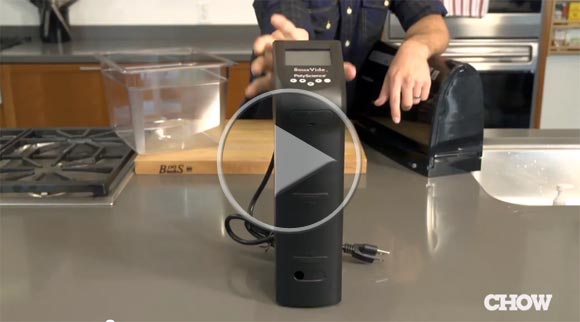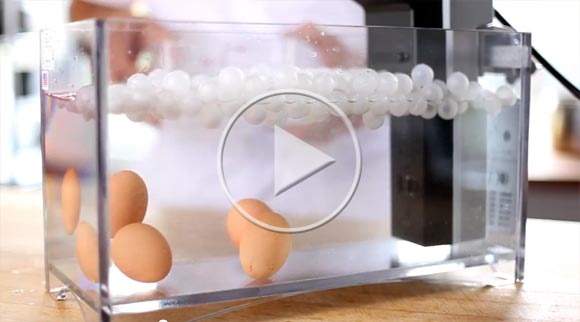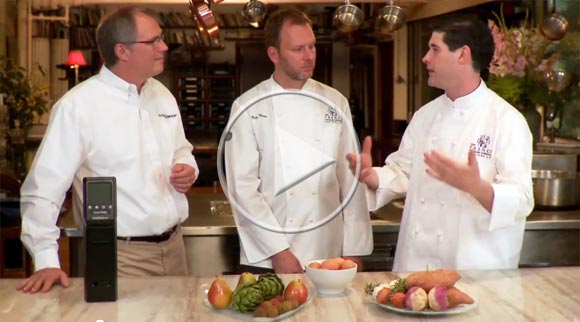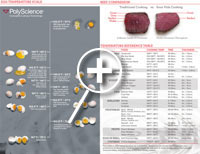History of Sous Vide
 While you'll seldom see the words 'sous vide' on their menus, this cooking technique — which literally means
'under vacuum' — was originally utilized in the early 1970s to minimize product loss when cooking foie gras, and is now being embraced by chefs worldwide for the preparation of an ever-widening array of dishes. With this technique, food is vacuum-sealed in a pouch and then slowly cooked at gentle temperatures. As a result, foods become tender without losing their original color, nutrients, and texture.
While you'll seldom see the words 'sous vide' on their menus, this cooking technique — which literally means
'under vacuum' — was originally utilized in the early 1970s to minimize product loss when cooking foie gras, and is now being embraced by chefs worldwide for the preparation of an ever-widening array of dishes. With this technique, food is vacuum-sealed in a pouch and then slowly cooked at gentle temperatures. As a result, foods become tender without losing their original color, nutrients, and texture.
Cooking entails heating foodstuffs to the right temperature, for the right length of time. The right temperature depends on the kind of food, e.g. meat versus fish versus vegetables, and depends on personal taste, e.g. rare versus medium. With all cooking techniques – including the microwave, and including sous vide – heat penetrates the outside surface of the food and eventually gets to the inner part, and then heats the center to the right temperature.
The problem comes into sight, for example, if you want a rare piece of beef; which means beef cooked to 125F°. You roast it in an oven at, say 400F°, by the time the center of the beef is at the right temperature of 125F° the outside of the beef is way overdone because it has been heated to 400F° for a long time: there's not just a tasty outside crust but much of the beef, excepting the center, is well done and gray.
On the other hand, if you 'roast' it at 125F° -- which nobody would do -- none of the beef gets overdone, but it takes so long for the heat to penetrate and raise the temperature of the center to 125F°, that the whole piece dries out; or if you stop roasting too soon to keep it from drying out the center is still raw.
With sous vide, you cook food at the temperature you want for the whole piece: no part is overdone or underdone; and by sealing the food in a vacuumed bag it does not dry out, lose nutrients or flavor during the long time needed to get the whole piece of food – outside and inside – to the right temperature and hence, to the right doneness.
Precise Temperature Control
 From a purely functional standpoint, cooking is the use of heat to induce chemical reactions, with different effects taking place at different temperatures. For example, the different proteins in the albumen of eggs coagulate at specific temperatures, and just a few degrees difference in cooking temperature will greatly affect just how much the egg white solidifies. The texture of the egg yolk also changes as its temperature rises.
From a purely functional standpoint, cooking is the use of heat to induce chemical reactions, with different effects taking place at different temperatures. For example, the different proteins in the albumen of eggs coagulate at specific temperatures, and just a few degrees difference in cooking temperature will greatly affect just how much the egg white solidifies. The texture of the egg yolk also changes as its temperature rises.
Temperate affects meat in a similar manner. Cuts with high collagen content, such as chuck and brisket, should be cooked longer and at higher temperatures to adequately break down this tough connective tissue. Furthermore, those cuts with little connective tissue (such as prime rib), can begin to get tough if cooked to those same temperatures. Just a few degrees can make a difference in an expensive cut of meat, turning it from tender and moist to tough and stringy; making this another benefit of sous vide cooking, where higher temperatures are not required.
The 'art' of sous vide cooking is in determining the perfect 'core' temperature you need to reach, in order to achieve the desired taste and textures. Take for example, a dish that features an egg with a creamy, custard-like texture. One chef might cook that egg to a core temperature of 143°F (61.7°C), while another may prefer cooking it to 146°F (63.3°C). While this temperature difference might seem insignificant, the finished eggs will be drastically different from each other, making each chef's dish unique.
The importance of precise temperature control underscores why the PolyScience Thermal Circulator is critical to sous vide cooking. Unlike slow cookers or simmering pans of water, the thermal circulator offers extremely precise temperature control along with 'set it and forget it' convenience. It can be set to cook food to an extremely precise core temperature — within a fraction of a degree — with just one single adjustment. You simply set it for the desired temperature, add the food, and walk away. Maintaining a slow cooker or pan of simmering water at just the right temperature is practically impossible, and repeatable results can not be achieved consistently. Also, because they don't circulate the cooking liquid, these devices can develop hot and cool zones that adversely affect the cooking process. This occurs because heat is transferred 100 times faster in water than in air. This is the reason why you can reach in an oven and take out rolls that are at 250°F, but you can't reach your hand into boiling water, even though it is at the same temperature.
Cooking Time
 Cooking times with the sous vide technique are affected by a number of factors, including the initial temperature of the food, its mass, and heat transfer characteristics. Remember however, that it's low temperatures for long periods of time that make the tantalizing results of sous vide possible. As a result, it will take some testing and experience to determine the proper amount of time needed for a dish to reach the desired 'doneness'.
Cooking times with the sous vide technique are affected by a number of factors, including the initial temperature of the food, its mass, and heat transfer characteristics. Remember however, that it's low temperatures for long periods of time that make the tantalizing results of sous vide possible. As a result, it will take some testing and experience to determine the proper amount of time needed for a dish to reach the desired 'doneness'.
In general, cooking time is affected by three factors: (1) the core temperature you wish to cook the dish to; (2) the heat transfer characteristics of the food; and (3) the amount of food that will be cooked at one time. Also, the greater the cooking liquid to food ratio, the faster each portion of food will reach the proper core temperature. PolyScience recommends that when cooking sous vide, that the cooking pouches be completely covered with liquid and that there is sufficient room for the pouches and cooking liquid to circulate freely.
Another important advantage of slow, low-temperature sous vide cooking: it becomes much harder to inadvertently over-cook a dish by leaving it in longer than necessary. Once a dish reaches the desired temperature, it will take a lot more time to keep cooking the foodstuff; meaning that it can be kept at that temperature — moist, delicious, and ready-to-serve — for a longer period without shrinking, drying out, or becoming tough. This is particularly advantageous when cooking expensive cuts of meat, such as Kobe/Wagyu beef.
Enhancing Presentation
 The enjoyment of food, be it a quick snack or a multi-course tasting menu at a fine restaurant, is a unique and very personal experience. To be truly fulfilling, it must please the senses — sight, smell, taste, touch, and even hearing. Who among us hasn't had our expectations heightened by the artistry of the presentation, the aroma wafting from the plate, or the sizzle of a hot dish of beef, lamb or pork?
The enjoyment of food, be it a quick snack or a multi-course tasting menu at a fine restaurant, is a unique and very personal experience. To be truly fulfilling, it must please the senses — sight, smell, taste, touch, and even hearing. Who among us hasn't had our expectations heightened by the artistry of the presentation, the aroma wafting from the plate, or the sizzle of a hot dish of beef, lamb or pork?
To complement and enhance its melt in the mouth tenderness, many chefs 'finish' sous vide meat dishes with a brief grilling or pan/blowtorch searing, inducing a Maillard reaction and thus creating the familiar aromas and flavors that come only with high-heat cooking. The critical difference with food cooked using the sous vide technique and finished in this manner is that the interior remains exceptionally tender and moist and there is very little, if any, of the shrinkage that occurs with traditionally grilled or roasted meat.
Cooking Sous Vide
 The sous vide cooking process is quite simple and basic.
The sous vide cooking process is quite simple and basic.
- Set the Thermal Circulator or Thermal Bath to the desired cooking temperature and heat the cooking liquid.
- Vacuum seal the food.
- Place the vacuum sealed food in the heated cooking liquid
The Thermal Circulator or Thermal Bath will apply additional heat as needed to maintain the cooking liquid at the desired temperature. And remember, while you can't inadvertently over-cook a dish with the sous vide method, you can under-cook it if you remove it from the heated cooking liquid before it reaches the desired core temperature.

